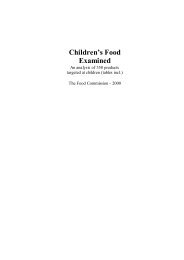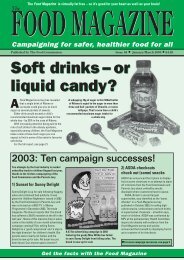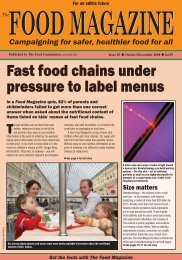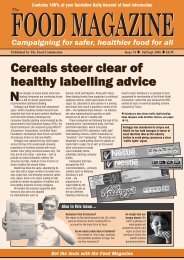Campaigning for safer, healthier food for all - The Food Commission
Campaigning for safer, healthier food for all - The Food Commission
Campaigning for safer, healthier food for all - The Food Commission
You also want an ePaper? Increase the reach of your titles
YUMPU automatically turns print PDFs into web optimized ePapers that Google loves.
news<br />
Manipulated<br />
desire<br />
Not so long ago, an American journalist<br />
with a long-standing interest in human<br />
behaviour wanted to find out what a<br />
curious-sounding body, the Institute of<br />
Motivational Research in up-state New York,<br />
was getting up to. He began collecting material<br />
published by this organisation and by other<br />
researchers into human motivations, and the<br />
results alarmed him.<br />
<strong>The</strong> researchers, he found, were not just<br />
dispassionate scientists analysing our<br />
evolutionary and soci<strong>all</strong>y-determined<br />
motivations but were developing methods <strong>for</strong><br />
applying their science to the manipulation of<br />
individuals' motivations, desires and behaviour.<br />
A technology <strong>for</strong> marketing was being<br />
developed, and there were no controls on its<br />
use. <strong>The</strong> journalist, named Vance Packard,<br />
compiled a manuscript containing his findings<br />
and submitted it <strong>for</strong> publication as a book fifty<br />
years ago this summer, in 1956.<br />
<strong>The</strong> book, <strong>The</strong> Hidden Persuaders, became a<br />
best-seller in the US and was published in the<br />
UK by Penguin in 1957. <strong>The</strong> publishers<br />
described it as 'An introduction to the<br />
techniques of mass-persuasion through the<br />
unconscious' and the book emphasised the<br />
extent to which the ef<strong>for</strong>ts of advertisers and<br />
marketers 'take place beneath the level of<br />
awareness so that the appeals which move are,<br />
in a sense, “hidden”'.<br />
From the outset, Packard was clear that the<br />
manipulation of desires and choices occurred<br />
through several strands simultaneously: product<br />
design, packaging, and display were as<br />
important as advertisements. <strong>The</strong> snap and<br />
crackle and pop of a cereal or the colour of a<br />
cherry-flavoured soda was as important in<br />
appealing to children's tastes as the cartoon<br />
characters on the package or the shape of the<br />
bottle, its display at child height on the shelf, or<br />
the offer of a<br />
free toy – and<br />
these acted in<br />
conjunction<br />
with TV<br />
commercials<br />
using bright<br />
colours,<br />
movement, music, familiar characters<br />
and recognisable logos.<br />
<strong>The</strong> leading users of this new<br />
technology made no secret of their<br />
intentions. Packard quotes the president of<br />
the Public Relations Society of America<br />
who said in a speech to his members '<strong>The</strong><br />
stuff with which we work is the fabric of men's<br />
minds'.<br />
Similarly, an advertising executive cited<br />
psychoanalytical research to explain why women<br />
would pay ten times as much <strong>for</strong> skin cream<br />
than <strong>for</strong> soap. Soap, he said, only promises to<br />
make them clean, whereas skin cream promises<br />
to make them beautiful. ‘<strong>The</strong> women are buying<br />
a promise. Cosmetic manufacturers are not<br />
selling lanolin, they are selling hope… We no<br />
longer buy oranges, we buy vitality. We don’t<br />
buy an auto (car), we buy prestige.’<br />
<strong>The</strong> need to manipulate people's motivation<br />
has been recognised by political and religious<br />
leaders <strong>for</strong> many millennia, but the past century<br />
has seen a specific application of the techniques<br />
of persuasion <strong>for</strong> commercial purposes. Packard<br />
recognised this, and noted that the commercial<br />
sector has 'more billions of dollars immediately<br />
at stake' and have poured resources into the<br />
marketing ef<strong>for</strong>t accordingly.<br />
<strong>The</strong> development of the science of<br />
influencing choice recognises three<br />
fundamentals, said Packard. Firstly, people may<br />
not know what they want. <strong>The</strong>y may tell pollsters<br />
and surveyors about their intentions, but these<br />
are not closely related to their actual behaviour.<br />
Secondly, people may not tell you the truth about<br />
their motivations even if they are aware of them.<br />
<strong>The</strong>y will only tell you what they want you to<br />
know, or what they think you want to hear.<br />
Asking your customers what they want or like is,<br />
says one consultant, 'the least reliable index' <strong>for</strong><br />
a manufacturer wanting to win new customers.<br />
Lastly, people do not behave ration<strong>all</strong>y. Tests<br />
in the 1950s by the Colour Research Institute<br />
asked housewives to test three new detergents,<br />
<strong>all</strong> of which were in fact identical in content and<br />
function. After the trial period the housewives<br />
reported that the detergent in a yellow box was<br />
considered too strong, and even ruined clothes,<br />
while that in a blue box was too weak and left the<br />
50 years of exposure: Vance Packard's seminal book<br />
revealed the methods used by advertisers to make us buy<br />
products – from cigarettes to cars, from religion to beer –<br />
whether we think that we want them or not.<br />
“It’s not just a crisp, Sharon,<br />
it’s alpha-male street cred!”<br />
clothes dirty. <strong>The</strong> most effective detergent, the<br />
users said, was in a mixed blue and yellow box.<br />
Men were just as irrational when it came to their<br />
views on the quality of cars.<br />
Advertising appeals not to our conscious<br />
thoughts but to our subconscious – our needs<br />
and fears, our childhood fantasies, our sexual<br />
desires. It uses colour and movement and<br />
humour and familiarity and surprise. By working<br />
at this level of brain activity, they bypass routine<br />
controls. <strong>The</strong>ir appeal is largely beneath the level<br />
of words and language, and this puts them<br />
beyond logical resistance or contradiction.<br />
This is the flaw with contemporary<br />
'educational' programmes like MediaSmart<br />
(www.mediasmart.org.uk) which are proposed<br />
by the advertising industry, and gaining political<br />
currency, as a means of explaining to children<br />
how advertising works. MediaSmart may teach<br />
us a lot about the way industry likes to portray<br />
itself, but it does nothing to protect us from<br />
commercial exploitation of our subconscious.<br />
Like stealth bombers, the advertising,<br />
packaging, shelf-positioning and other tricks of<br />
the trade get to us beneath our radar. However,<br />
much of our social discourse operates at a<br />
similar level, of course, and it would be a dull<br />
world indeed if we had to justify <strong>all</strong> our actions<br />
on a rational basis.<br />
But to use these direct pathways <strong>for</strong><br />
commercial exploitation is deeply immoral,<br />
argues Packard. ‘I prefer being non-logical by<br />
my own free will and impulse,’ he declares,<br />
‘rather than to find myself manipulated into such<br />
acts. <strong>The</strong> most serious offence many of the<br />
depth manipulators commit is that they try to<br />
invade the privacy of our minds.’<br />
<strong>The</strong> words echo as strongly now as they did<br />
when first published. Marketeers continue to<br />
persuade us to buy products we don't re<strong>all</strong>y want<br />
and which undermine our health, using methods<br />
of deep manipulation that are just as well hidden<br />
now as they were 50 years ago.<br />
<strong>Food</strong> Magazine 73 15<br />
Apr/Jun 2006














